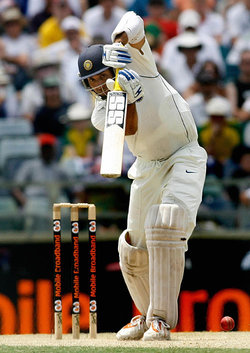VVS Laxman: Languid and Imperious
Gareth Bland |
And so now only Tendulkar remains. With the retirement this week of Vangipurapu Venkata Sai Laxman – VVS to the cricketing world – India mourned the passing from the scene of the third of the Fantastic Four of batting talents that have carried the weight of the nation’s considerable expectations for over a decade and a half. In a short documentary made in December 2008 Sachin Tendulkar, Sourav Ganguly, Rahul Dravid and VVS Laxman were each likened to the four basic elements of nature: Tendulkar being the air, Ganguly the fire, Dravid the earth and Laxman, fittingly given the fluid style of his play, water. Now that the fire has been doused, the earth raked over and the water supply abruptly switched off, only the air granted us by Tendulkar is left.
After 134 Tests stretching back to 1996, VVS felt that it was time to go, his remaining ambition in the game being a domestic affair: to lead his beloved Hyderabad to success in the Ranji Trophy. Less than three months shy of his 38th birthday, VVS’s departure also highlights generational trends within the Indian side. Whatever the truth about his relationship with Indian skipper MS Dhoni, the captain’s absence from a farewell bash given in Laxman’s honour this week and a general feeling that the Hyderabad star was unappreciated by the leadership and by selectors, in particular Kris Srikkanth, the episode has been an intrigiguing side narrative to the main issue of the loss to the international game of this elegant, Rolls Royce of a batsman.
Some players leave the stage defined by mere statistics, as if leafing through Wisden alone can bring the memory of their deeds alive. Not so VVS Laxman. Here was a player so grand, so majestic in full flight that even his exalted team-mates, some of whom number among the very greatest to have played the game, chose to simply sit back and watch. During their epic 353 run stand in 2004 in Sydney even Tendulkar was moved to remark I just decided I was going to stay there and watch from the non-strikers end. Similarly, Rahul Dravid joined Laxman in a partnership of 376 in Kolkata during VVS’s career defining 281 in 2001-02 and even he remarked It was like watching a highlights package. Even watching the highlights of that innings almost eleven years on is a surreal experience. Made to follow on, VVS sauntered to the crease in what looked like a hopeless cause. Twenty years on from Headingley, the Australians were, once again, players in a drama that will be recollected and reminisced over as long as the game is played. Once again having enforced the follow on, Australia contrived to lose from what appeared an almost impregnable position. Their nemesis this time, however, was no Botham. Watching those highlights again this week is almost enough to make the viewer feel sorry for the Australians. The willowy 6′ 1″ figure at the strikers end, seldom moving far from the crease, unfurled one crisply timed stroke after another, boundary after boundary met by a cacophonous roar which increased in intensity the longer the innings went on. On a desert of a Kolkata outfield, Warne, McGrath, Gillespie et al toiled for what seemed like weeks on end only to have their sweat drenched deliveries despatched to the fence by a series of on drives, off drives, straight drives, square drives, square cuts, back cuts, swivelling pulls and clips off the legs. Warne, a vision of parched blonde weariness, resembled a heavyweight Peter O’Toole in Lawrence of Arabia as he toiled away, hour after hour in the searing heat. Sighting the ball like a beach ball, Laxman reached his 200 with his 35th four, incredibly 140 of his runs having come from boundaries at that point. It looked absurdly easy; it was as though someone had forgotten to mention to him that this was a Test match, that this was the greatest bowling line-up of the modern game.
If that 281 was a career changing knock which elevated him to the premier league of international batsmen, then his arrival in 1999/00 at Sydney was equally spectacular coming, once again, when his side were up against it. Expressed simply, when he departed the scene having made 167 India were 258-8. He had struck 108 of his runs in boundaries off just 198 balls. Averaging a mere 24 at this stage of his career having entered Test cricket in 1996 against South Africa, Laxman simply plundered the Australians that day with a virtuoso series of strokes. His obvious liking for the Australian attack accounted for 6 of his 17 centuries in total, averaging 49.67 against the world’s premier team. During his 178 on the same Sydney ground in 2004 he pounded poor Brett Lee to such an extent that he conceeded in excess of 200 in that innings. The choice of the word pounded is probably misleading not to say profoundly wrong, though, for VVS rarely seemed to exert more than the minimum of manouvrability in each stroke, letting the blade do the work in an almost uncanny synergy between man and bat. In his 109 against Australia in 2008, he left a metronomic Stuart Clark nonplussed when a series of full length, blockhole bound deliveries were simply placed straight back beyond the bowlers hand, along the floor for boundaries. In one instance VVS had not even deigned to follow through, the expression on Clark’s face being a mixture of resignation and wonder as the ball sped to the boundary.
He was not always on his game, however. VVS did not triumph in all surfaces, in all conditions as his exalted team-mate, Tendulkar, has. An inability to combat seam and swing on softer surfaces reduced his effectiveness to an average of a mere 30.64 from 17 Tests against England and 37.53 in 19 Tests against South Africa. Moreover, in a combined total of 36 Tests against those foes he made just one century, an innings of 143 against South Africa in India. He may have made batting look easy and he may have looked as though he was barely breaking sweat, but this was no dilettante. Scrape at the polished veneer of elegance and it revealed steel sure enough. Just as his 281 in the follow on in Kolkata helped India rescue a lost cause and bowl Australia out to win from the follow on, so VVS’s inspired 96 against the South Africans in Durban helped his side set the hosts a target of 303 in 2011. That 167 in Sydney back in ’99/00 also came as all around him floundered, while the backs to the wall partnership of 303 with Rahul Dravid in Adelaide in late 2003 was yet another sublime example of counter attacking after India had been reduced to 65-4. A VVS cover drive sent zooming to the fence that day moved Greg Chappell to remark that was both languid and imperious.
In a documentary tribute to David Gower made in the late 1980s, Ted Dexter argued that some batsmen are successful without being easy on the eye, while others were a delight to the aesthete though ultimately unsuccessful. Gower, he argued, was fortunate in being both successful and attractive to watch. Gower, the kind of player, even today, who when recalled at his best can still bring a lump to the throat of those that saw him, shares much in common with Laxman. Overall, they share the unique gift of being remembered as batting in a way that most of us can only dream of. VVS was the kind of player who would produce strokes at will that the lesser mortals among us would attempt in vain during our futile weekend forays. He was someone, too, who could induce that same envy and admiration among his own team-mates, some of whom, as we know, were not half bad themselves. For the record, VVS Laxman made 8781 runs at 45.97 with 17 hundreds and 56 fifties. He was often overlooked for the one day game, perhaps his technique was a little too “pure” for one coming in relatively low in the order. Even so, in 86 one day internationals he notched up 2338 runs at 30.76 with 6 centuries. His metier was the Test match, though, and his elegance, deft touches on the ball and astute placing – working the ball around with wrist work and observing the most elemental commandment of batsmanship, playing straight – are revealed in a startling statistic: in his entire Test match career he hit a total of just 5 sixes. Favouring the pull over the hook, he usually hit the ball downwards after rolling the wrists over the top of the bat handle to control the elevation.
And so VVS Laxman departs international cricket, following in the footsteps of Zaheer Abbas, David Gower and Mark Waugh as the kind of player that neutrals would cherish and opposing fans secretly wish to succeed. In his own country’s tradition he does, of course, bear unmistakable stylistic similarities to his idol and fellow Hyderabad native, Mohammed Azharuddin. In terms of his ability to mix it with the best of his era, though, he became to his era what Mohinder Amarnath was to his. Just as Amarnath defied the West Indies pace quartet in a way none of his contemporaries even dared, so VVS saved his greatest performances for the Australians.
Life without VVS will go on, of course. Having lost Ganguly in 2008, Dravid earlier this year and now Laxman himself, the Indian batting landscape will take on a different complexion, with the last, great image in India’s Mount Rushmore of batsmanship, Tendulkar, still there alone after almost 23 years. Whatever the truth regarding the supposed spat beween Laxman, skipper Dhoni and selector Srikkanth, all teams must evolve and adapt eventually. Preparing for that is never easy nor seldom pain free, especially when the players nearing the end are icons who have become part of the national furniture for as long as Laxman has. Never having being touted for the captaincy himself we can only imagine the internal politics and dressing room dynamics created by him being led by junior players as the selection team prepare for the future. Whoever comes along to take his place in the side they will need to go a long way to make batting look as pleasureable or as easy as VVS made it look. Approaching 38 in November he no doubt needs a rest and must be relishing the time ahead with his young family. After all,if, as David Gower once remarked in one of his typical asides It’s hard work making batting look easy, VVS Laxman must be simply exhausted.





Excellent! Thank you Gareth
Comment by Senile Sentry | 12:00am BST 26 August 2012
what a beautiful article.
VVSL batting was like eating chocolate.
I love it!!
Comment by aditya | 12:00am BST 5 September 2012